We love to plant tomatoes in our garden in the spring. We always underestimate how many tomatoes each plant will give us, so we end up with so many ripe globes of goodness!
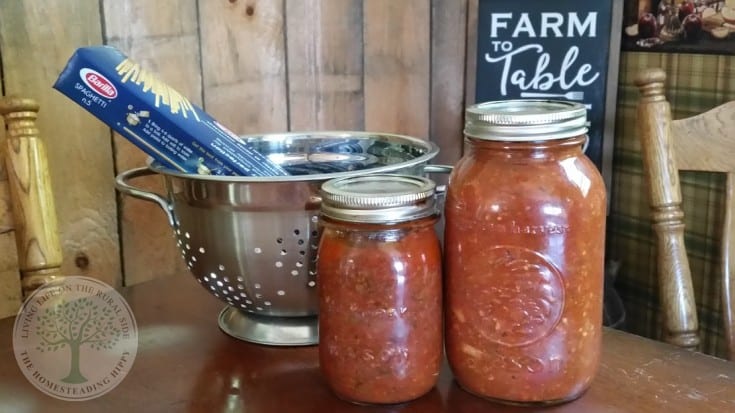
Fortunately, there are salsas to be made, chilies to be eaten, and pizzas to be baked. There is also pasta.
Oodles and oodles of pasta to be eaten. Thick, homemade noodles, with homemade spaghetti sauce just clinging to each and every strand.
Parmesan cheese with all its melty goodness, dripping down the fork or your chin. THAT’S the reason we plant tomatoes.
Why You Should Make Your Own Tomato Sauce
There are plenty of excellent reasons to make your own tomato sauce at home – for one, it’s absolutely delicious! It will also help you use up the onslaught of tomatoes that you have in your garden each summer and fall.
But homemade spaghetti sauce is worth the effort for other reasons, too. For one, it can be cheaper. Sure, you have to factor in your time, but growing your own tomatoes can really save you some money if you like having a consistent abundance of fresh produce at all times.
Plus, it’s healthier. Store-bought tomato sauce is often loaded with preservatives, sugar, and salt – something you really don’t need more of in your life.
When you make your own homemade spaghetti sauce, you can accurately control for all of these in your own kitchen. You can also add your own spices or herbs to give your sauce that perfect flavor you love and cherish.
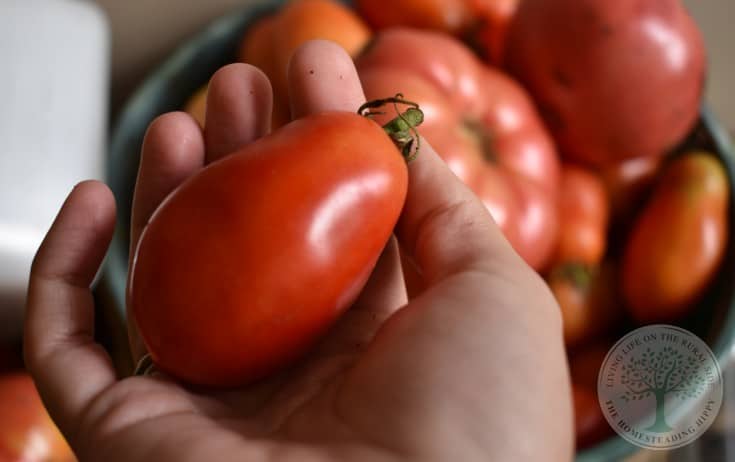
What Kinds of Tomatoes Should I Use?
I’m often asked what the best kinds of tomatoes are for making homemade sauce. The short answer is that just about any kind of tomato will work beautifully in a sauce – especially a homegrown tomato!
There is nothing like the sweet, succulent flavor of a tomato to really jazz up the flavors of a homemade sauce.
However, there are definitely some types of tomatoes that work better than others in a sweet, juicy sauce. If you want a truly tasty sauce, I recommend going with a paste tomato. These have a firmer, meatier texture and they also contain less water and fewer seeds that you’ll have to deal with.
The result? Less mess, less prep work, and less cook time – plus, more sauce for your money!
When you’re considering paste tomatoes, my two personal favorites are San Marzanos and Romas. Romas are the classic tomatoes used in Italian cooking, and if you’ve ever made your own tomato paste, you probably already know that Romas are the way to go.
Romas are small, usually only about three inches long (although there are some longer varieties now available). Romas aren’t usually as sweet as other paste tomatoes, so you might need to add some sugar if you prefer a sweeter sauce.
Another popular kind of tomato for sauces is the San Marzano. Another classic paste tomato, the San Marzano has a dry, dense flavor. It’s sweeter than a Roma but is about the same size (often smaller).
You can also choose oval tomatoes, like Amish Paste or Opalka. Amish Paste tomatoes look a lot like Roma tomatoes, but they are sweeter and larger.
They can be as big as 12 ounces! Opalkas, on the other hand, are unique polish heirloom tomatoes that are richer and more flavorful than other varieties of paste tomatoes. They are long and pepper-shaped, growing up to six inches long.
While all of these types of paste tomatoes are delicious and easy to grow in the garden, they are relatively small. This can increase the amount of work that you have to do in order to get enough sauce for canning.
If you’re in the market for a larger tomato, you’ll have plenty of good sauce tomatoes to choose from, too.
Big Mama is one such option. A plum-shaped tomato, Big Mama is meaty and large. In fact, it can grow up to five inches long and three inches across! A favorite among gardeners, it is smaller and easier to process than a Roma.
Another option is the Jersey Giant (no, not the chicken!). This type of tomato can be difficult to find, but if you’re able to track it down, you’ll reap the rewards.
An heirloom paste tomato, it grows up to six inches long and just a few plants will yield you all the tomatoes you need.
When you are looking for the best tomatoes for sauce, remember the golden rule when it comes to cooking and canning – the quality of your final product will only be as good as the quality of the ingredients that you use.
Most of the tomatoes I’ve mentioned are determinate varieties, meaning they ripen all at once. That’s good news for making sauce and tomato paste!
Otherwise, look for tomatoes that are ripe and firm, with as few bad spots as possible (although you will be able to cut some of these out, of course).
If you find that you have more tomatoes than you know what to do with and the canner is already full, keep in mind that you can always blanch and then freeze extra tomatoes to make sauce later on in the season, when your schedule frees up a bit.
A Few Recipe Notes
In my homemade spaghetti sauce recipe, I sought to make things as easy as possible – therefore, I used a crockpot and fresh herbs right from my garden.
However, keep in mind that you could also recreate this recipe on your stovetop. You don’t need to use a slow cooker. The main thing is that you will need to stir it constantly to prevent it from clumping to the bottom or the sides of the pot.
If your sauce is too thin – which commonly occurs when you use non-paste varieties of tomatoes, like Big Beef or cherry tomatoes – you may need to thicken it up.
This is most easily done with making a cornstarch roux. It thickens the sauce up nicely!
Just make sure you don’t dump in the cornstarch all at once. You really need to take the time to shake things up and get them nicely blended so that all of the ingredients meld well.
Finally, when it comes to herbs, keep in mind that fresh or dried will work just fine. You can even use frozen herbs, if you desire!
You can add other herbs besides the ones that I listed in this recipe, too, such as oregano, parsley, or thyme – the choice is up to you.
I have even heard of cooks who like to add spicy flavors like cumin or red pepper flakes to their spaghetti sauce.
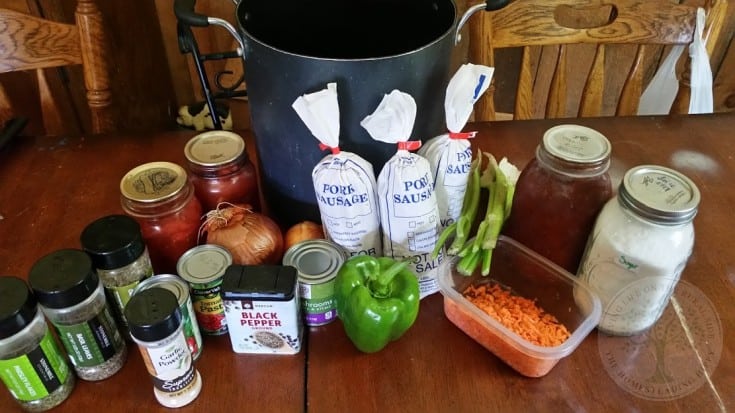
Our easy, homemade spaghetti sauce is really quite simple. You can make this on the stove top, or in the crock pot on those busy days. Or, ahead of time for those super hot days, when you don’t want to add to the heat in the kitchen.
Homemade spaghetti sauce is just versatile like that. Of course, I may be biased, but I think this is the best homemade spaghetti sauce recipe from scratch you can make.
You can pour it over pasta, dip homemade French bread in it, or even use it on homemade pizzas. Making and canning a meatless spaghetti sauce will give you a wide variety of uses.
Homemade Spaghetti Sauce
Ingredients
- 8 lbs ripe tomatoes
- 3 medium green peppers chopped
- 2 medium onions chopped
- 3 cloves garlic crushed
- 15-20 fresh basil leaves or ¼ cup dried
- 2 tsp sugar to cut acidity from tomatoes
- salt and pepper to taste
Instructions
- Core the tomatoes and place in the crock pot whole.
- Remove the seeds from the green pepper and roughly chop.
- Remove the onion skin and roughly chop.
- Peel and crush garlic cloves and dice.
- Add all the ingredients to your crockpot.
- Cook on low for 6-8 hours.
- Blend smooth with a stick blender. If you don’t have a stick blender, you can add it to your regular stand blender in batches to process.
- Return to the crockpot and cook on low another 6-8 hours, with the lid slightly off to allow steam to escape.
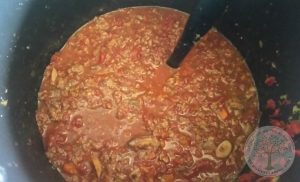
- When the sauce is mounded up on a spoon, it is ready. Check taste for seasonings and adjust salt and pepper or sugar as necessary.
Homemade Spaghetti Sauce For Canning
- Prepare quart jars by washing and sanitizing in boiling water.
- Prepare new lids by simmering in hot water for 5 minutes.
- Prepare bands by washing in hot water.
- Add the hot sauce to the sterilized jars, allowing for 1/2” head-space.
- Wipe the rim of the jar clean with a damp towel to remove any food or grease.
- Add the simmered lid and clean band, twisting down finger tight.
- Process in a pressure canner for 45 minutes at 10 lbs pressure, adjusting for altitude according to your canner’s manufacturers specifications.
- Allow canner to cool completely, then remove jars.
- Cool jars in non drafty area for 12-24 hours to allow to cool.
- Check lids by pressing on them. Those that pop back are not sealed and should be stored in the fridge and used within 3 days.
- Remove the bands from the jars.
- Wipe jars down with hot soapy water, and store in your pantry for up to 1 year.
Notes on Canning Homemade Spaghetti Sauce
First, if you have such an onslaught of tomatoes and sauce that you need to runt he canner, don’t feel as though canning is your only option.
Freezing is another easy way of preserving spaghetti sauce, and you don’t need to have any special equipment or skills to be able to do so.
It can extend your harvest just as well as canning is able to – plus, you won’t have to heat up your house.
Also, when you’re canning, always use a pressure canner. Some people argue that spaghetti sauce can be canned in a water bath canner since it is primarily tomatoes, which are high-acid foods and therefore can be processed (on their own) in a water bath without needing to add things like vinegar.
However, when you are making spaghetti sauce, you are adding low-acid foods like garlic, peppers, and onions.
Those foods cannot be safely canned except for in a pressure canner, so you will need to accommodate for this by canning everything together in a pressure canner. Don’t gamble on this! It’s not worth getting sick.
Are you making your own homemade spaghetti sauce this year? Will you try this recipe? Be sure to pin this for later!
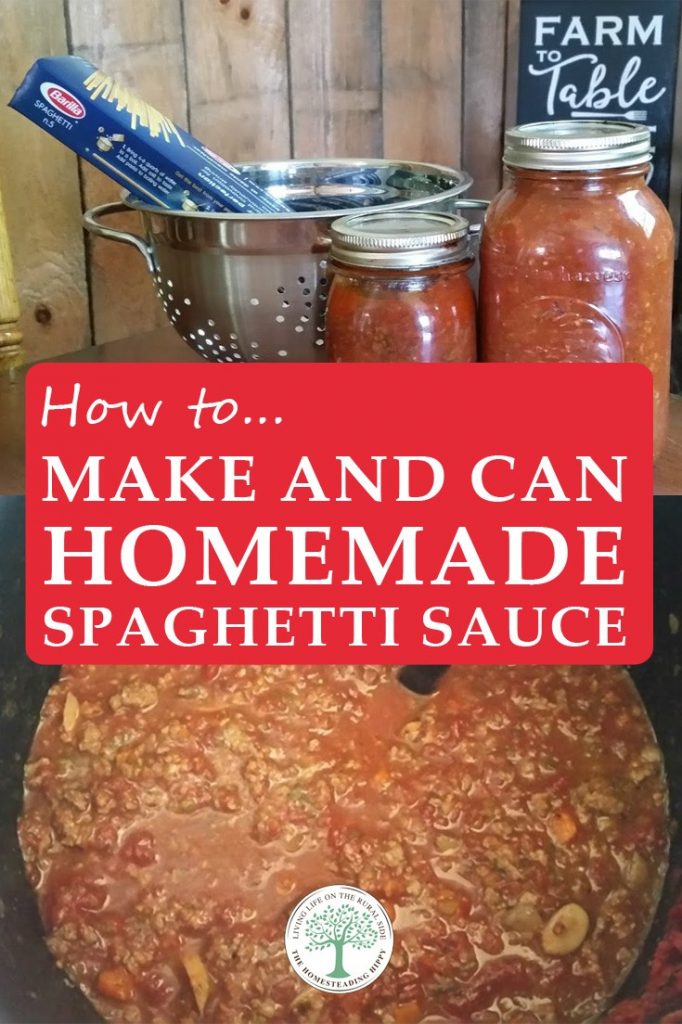

Heather’s homesteading journey started in 2006, with baby steps: first, she got a few raised beds, some chickens, and rabbits. Over the years, she amassed a wealth of homesteading knowledge, knowledge that you can find in the articles of this blog.
Learn more about Heather and the rest of the writers on this page.

This has basil leaves on the ingredients twice? Is it supposed to be something else or was this a typo?
That was listed twice, I fixed it.